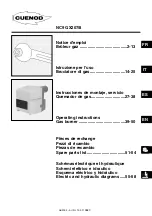
20
Creosote Formation
A small intense fire is preferable to a large smouldering one, to reduce the amount of
creosote. When wood is burned slowly it produces tar and other organic vapours, which
combine with expelled vapour to form creosote. These creosote vapours condense in the
relatively cool flue of a slow burning fire. As a result, creosote residue accumulates on
the flue. When ignited, this creosote makes an extremely hot fire.
The flue should be checked at least every 2 months, during the burning season, to
determine if a creosote build up has occurred. If this is the case, it should be removed
by a chimney sweep to reduce the risk of an unexpected flue fire.
Your appliance has been designed to produce low levels of creosote at high and low
settings.
In the event of a chimney fire, close the firebox door, fully close the heat
control, vacate the premises and call the fire service.
Storage of Fuel
Do not store fuel within installation clearances or within the space required for refuelling
or ash removal.
Wood should always be stored in a dry place out of the rain. We recommend your wood
be seasoned for at least 3 months before use. Dry wood also burns hotter and more ef-
ficient than wet wood.
The fuel approved for use in Clean Air Zones in this appliance is wood with a moisture
content of less than 25% of dry weight. This usually means green timber left for at least
three months to air dry.
Содержание FERVA SATURN
Страница 3: ...3 Dimensions Fig 1...
Страница 7: ...7 HeatSaver Flue Kit Installation Flue Shield None required...
Страница 8: ...8 HeatSaver Flue Kit Installation...
Страница 9: ...9 HeatSaver Flue Kit Installation...
Страница 10: ...10 Columbia Cowl...
Страница 11: ...11 HeatSaver Flue Kit Installation...
Страница 18: ...18 Consumables Ash Tray Crucible Parts Crucible Cap Crucible Tube Centre Baffle...
Страница 19: ...19 Consumables Fire Bricks...





































